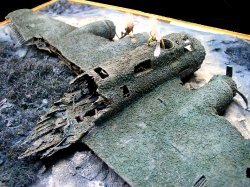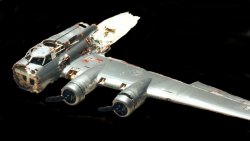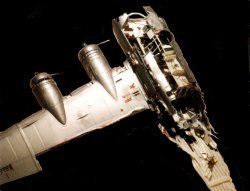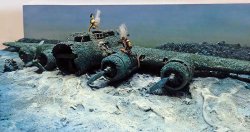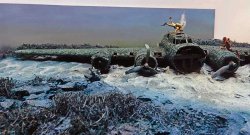SP Maquettes

Galerie * Gallery - LE B17 DE CALVI
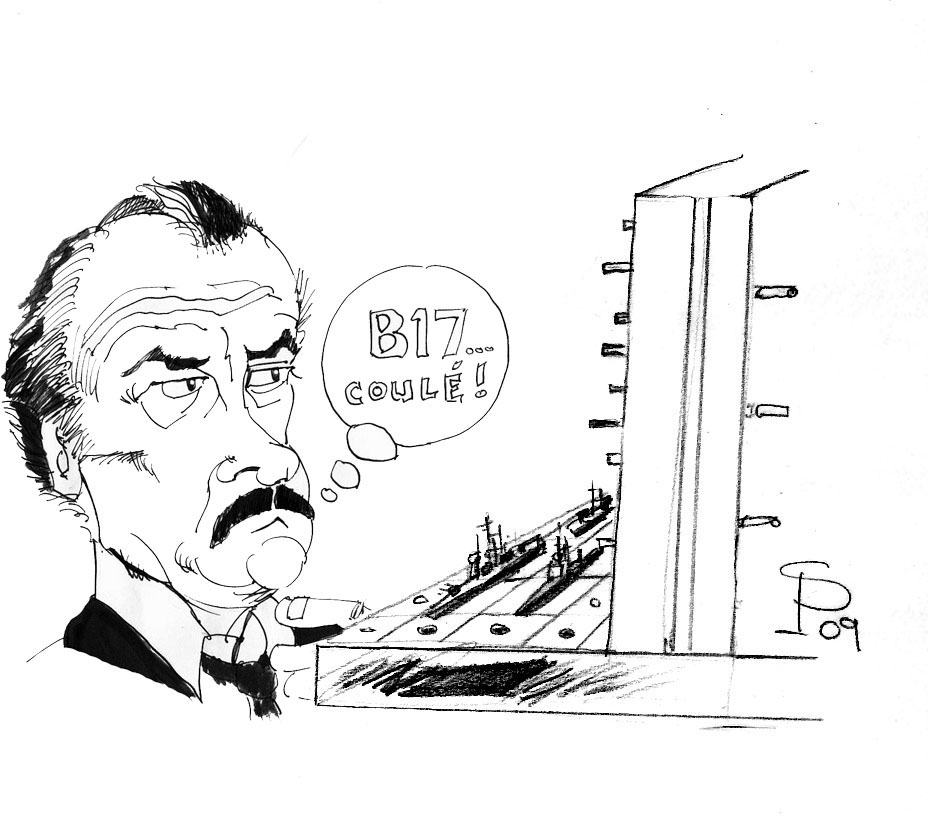
"B17...Sunk !"
De nombreux avions tombés en mer pendant la deuxième guerre mondiale se trouvent en Méditerranée, le long des côtes françaises. Un exemplaire du bombardier américain BOEING B-17 Flying Fortress - gît par 27 mètres de fond, près de la forteresse de Calvi, en Corse.
La maquette est le B-17 G de la marque MONOGRAM à l'échelle 1/48ème. Les plongeurs sont réalisés à partir de l'équipage fourni dans la boîte.
Cette forteresse volante était un modèle B 17-G, avec pour numéro de série 4231044, basée en Italie du sud. Elle décolla pour sa dernière mission, le bombardement des installations ferroviaires de Vérone, le 14 février 1944 avec aux commandes Frank Chaplick le pilote. Pendant l'approche de l'objectif, l'avion se trouva soudain isolé. Il fut aussitôt attaqué par des chasseurs ennemis - les terribles Messerschmitt 109 - qui mirent hors service un moteur et endommagèrent les compresseurs de deux autres. Le pilote réussit à atteindre la piste de Calvi, mais celle-ci trop courte pour un bombardier, il vira vers la mer avec un seul moteur restant. Il largua le reste des munitions - plus d'une tonne - redressa l'avion et commença à freiner avec la queue qui se brisa lors de l'impact avec l'eau. Il resta en surface deux minutes, juste le temps aux six survivants de l'évacuer.
Quand le plongeur Paul Valeani découvrit l'avion en 1963, il était en très bon état de conservation. Il y avait deux mitrailleuses, une sur le fond, et l'autre dans l'habitacle avant, en parfait état de fonctionnement. Un grand nombre de parachutes fut également trouvé, plus nombreux que l'effectif de l'équipage embarqué, ainsi que des réservoirs d'oxygène et les restes des aviateurs..
La maquette est le B-17 G de la marque MONOGRAM à l'échelle 1/48ème. Les plongeurs sont réalisés à partir de l'équipage fourni dans la boîte.
Many aircraft that fell at sea during the Second World War can be found in the Mediterranean, along the French coast. An example of the American BOEING B-17 Flying Fortress bomber - lies in 27 meters of water, near the fortress of Calvi, Corsica.
This flying fortress was a B 17-G model, serial number 4231044, based in southern Italy. It took off on its last mission, the bombing of Verona's railway installations, on February 14, 1944, with pilot Frank Chaplick at the controls. As the plane approached its target, it suddenly found itself isolated. It was immediately attacked by enemy fighters - the dreaded Messerschmitt 109s - which disabled one engine and damaged the compressors on two others. The pilot managed to reach the runway at Calvi, but it was too short for a bomber, so he turned towards the sea with only one engine remaining. He jettisoned the rest of the ammunition - over a tonne - righted the plane and began braking with the tail, which broke on impact with the water. It remained on the surface for two minutes, just long enough for the six survivors to evacuate it.
This flying fortress was a B 17-G model, serial number 4231044, based in southern Italy. It took off on its last mission, the bombing of Verona's railway installations, on February 14, 1944, with pilot Frank Chaplick at the controls. As the plane approached its target, it suddenly found itself isolated. It was immediately attacked by enemy fighters - the dreaded Messerschmitt 109s - which disabled one engine and damaged the compressors on two others. The pilot managed to reach the runway at Calvi, but it was too short for a bomber, so he turned towards the sea with only one engine remaining. He jettisoned the rest of the ammunition - over a tonne - righted the plane and began braking with the tail, which broke on impact with the water. It remained on the surface for two minutes, just long enough for the six survivors to evacuate it.
When diver Paul Valeani discovered the plane in 1963, it was in a very good state of preservation. There were two machine guns, one on the bottom, the other in the forward cockpit, in perfect working order. A large number of parachutes were also found, more than the number of aircrew on board, as well as oxygen tanks and the remains of airmen...
The model is the MONOGRAM B-17 G in 1:48 scale. The divers are based on the crew supplied in the box.
The model is the MONOGRAM B-17 G in 1:48 scale. The divers are based on the crew supplied in the box.
Powered by Phoca Gallery















